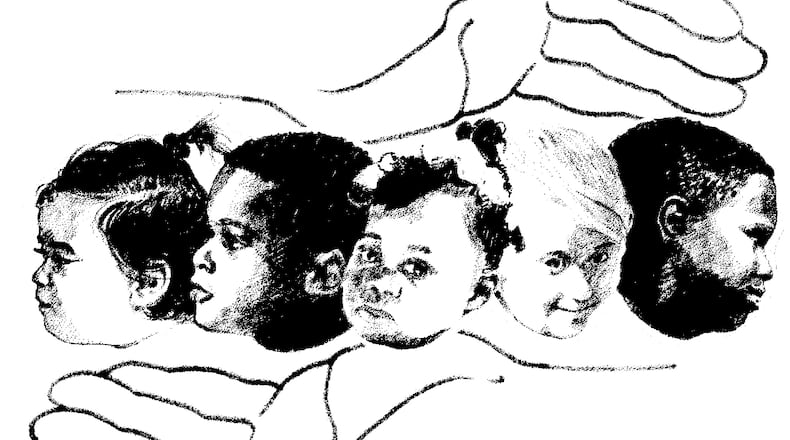Tyler Thigpen is co-founder of the Forest School: An Acton Academy in south metro Atlanta, and partner at Transcend, a national nonprofit accelerating innovation in the core design of school.
Thigpen is the former head of the upper school at Mount Vernon Presbyterian School in Atlanta and co-founder and board member of Chattahoochee Hills Charter School. He holds a doctoral degree in education leadership from Harvard Graduate School of Education, a masters in public administration from Harvard Kennedy School of Government, and a masters in theology from Regent College.
By Tyler Thigpen
A friend of mine lives in Lincoln, Massachusetts, a small town in the Greater Boston area. One of her neighbors invited her over to see the work of an extracurricular robotics club called GearTicks, made up of elementary- and high-school-aged kids in the area.
Much to her amazement, she entered the neighbor’s basement to find a large, buzzing workshop with dozens of kids in brightly colored T-shirts busy with different projects. A 3-D printer was humming away, and a red-haired boy of about 11 named Ken told her what it was doing.
“We’re making prosthetic hands,” he explained. “We’ve partnered with the Maker Club of the Perkins School for the Blind to make these”—and here he showed her the fully mechanical finished product—”which are going to go to kids who need them.”
Credit: Maureen Downey
Credit: Maureen Downey
The prosthetics are low-tech, but they serve an important purpose: they give kids who don’t have access to expensive medical care the ability to pick things up. Like balls. And clothes, and cups, and silverware. And toys.
There are so many things I love about this story. For starters, my friend couldn’t believe how articulate Ken was in describing the project. It was obvious he was passionate about the details, and he was excited to talk about it.
Secondly, the team collaborated with students at the Perkins School to create and assemble more than 20 prosthetic hands. The project brought GearTicks team members together with kids who are visually impaired to work on a mutual goal, which taught everyone involved valuable lessons in problem-solving. Most importantly, it seemed, everyone had fun.
And thirdly, the GearTicks and Perkins School teams took on the work of building prosthetic hands because they were interested in helping people. That made a world of difference in engaging kids in solving a complex problem. It developed their sense of curiosity and empathy about the lives of others.
A few years ago, a school where I was principal piloted a program that had teachers make a small, simple change to the way they reviewed and graded students’ work. It consisted of one extra line at the bottom of the rubric and one question to the student.
How did your work help someone else?
When we asked students to add human-centered impact in their schoolwork, the results were beautiful.
Students began connecting the ideas and problems they were solving in school to real people and real world issues. Kids that got the opportunity to see that the work they were doing had a greater impact than the letter “A” in red on the paper. Classroom engagement shifted and students were looking for more and more complex issues to apply what they were learning to solve.
Under best practices, part of this teaching method involves collaborating with experts outside of the school system. Students interact with business people, politicians, and nonprofit leaders on campus, which has the dual benefit of providing insights both for students in real-world problems, as well as providing members of the community insights into the next generation. These meaningful interactions lead to communities that come together to focus on human-centered impacts.
Since the addition of this question, we’ve been able to measure several different amazing, revolutionary changes that come from implementing this one small question. Here are a few:
Children are more empathetic.
When we ask, “What would the world look like if we trained our children to look for and solve problems in the world around us? What if we could instill in students the value of looking out for and caring about other people?” The result is that children start thinking about their place in the world, and ways they can contribute.
Not only does empathy spread among students, but in teachers who are looking for answers to problems in their local communities. School curriculum becomes a laboratory for real-world problems, taking the unburdened creativity and freedom from restraints that can result from children’s imagination. Teachers can, for example, bring a question to students about banning plastic grocery bags in their municipality, and assign them to research environmental impacts, politics, and best practices from other cases. Tackling a real-world issue connects the dots for students that their efforts to grasp new material can make a big difference in their communities.
Children become well-rounded, self-sufficient thinkers.
In what we often refer to as “real world,” adults are very rarely using singular bases of knowledge, or “subject silos,” to solve problems. Machines are increasingly overtaking simple tasks; it’s up to humans to think through complexities. A mix of information is needed, even for tasks as simple as grocery shopping—because that requires a knowledge of budgeting, nutrition information, health considerations, and, ideally, awareness of environmental and labor impacts on the food we eat as well. Partitioning out subject areas into separate studies (math, science, history) without tying them together fails our students, and our world, in seeing the bigger picture.
Human-centered learning approaches give kids, teachers, and parents the challenge to combine thought processes and subjects that position the student to make connections between what they’re learning in school and the real world. The earlier in life students can make these connections, the more curious they’ll be about the world around them, and that leads to well-rounded, self-sufficient thinking.
Children learn skills in collaboration and active listening.
Under a human-centered teaching model, teachers collaborated with each other and with non-academics to create projects that require the integration of English, math, science, and history to frame problems in the real world. The results of this style of teaching benefits not just students, but teachers as well: developing multidisciplinary learning helps keep teachers connected and engaged in the process and avoids burnout.
But most importantly, perhaps, is the skills students develop in collaboration and active listening. Time and time again, we as adults face situations where we are unable to solve problems alone. It takes a village, so to speak, and learning how to pull together teams and develop skills in engaging team members goes well beyond subject matter expertise: it teaches people how to be stronger together.
The world really does become a better place.
Of course, designing for new educational models has a larger aim in mind: a better world. While we are certainly interested in the betterment of individual students, it’s their collective successes and capabilities in the realms of empathy, self-sufficiency, and collaboration that are going to tackle some of the most pressing global issues sooner and more intentionally. We cannot rely on fate or luck to drive young people toward the levels of complex thinking required to create a more egalitarian and peaceful society. We have to embed that culture in their learning as early as possible. And it can begin with the simple question: what did you do to help someone today?
About the Author
Keep Reading
The Latest
Featured



